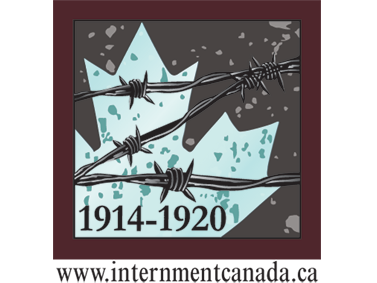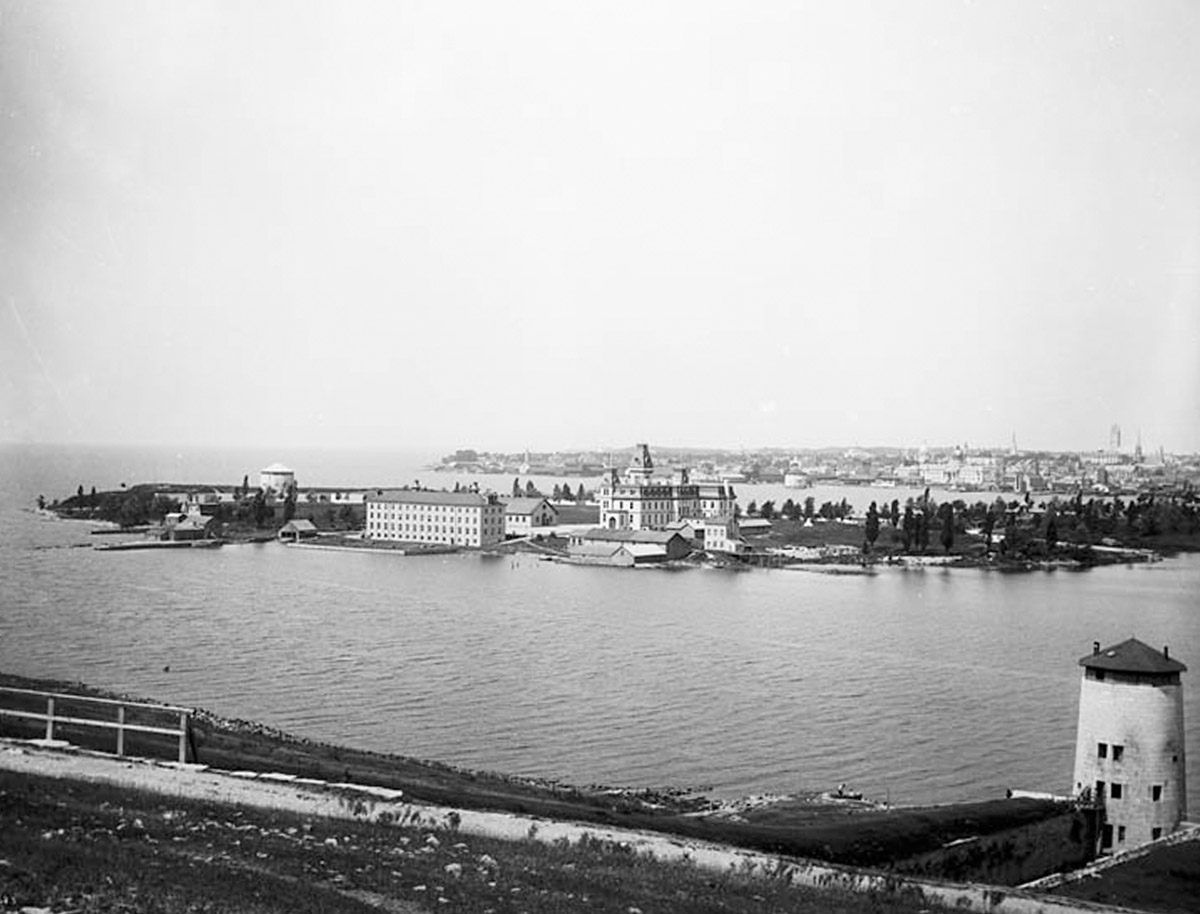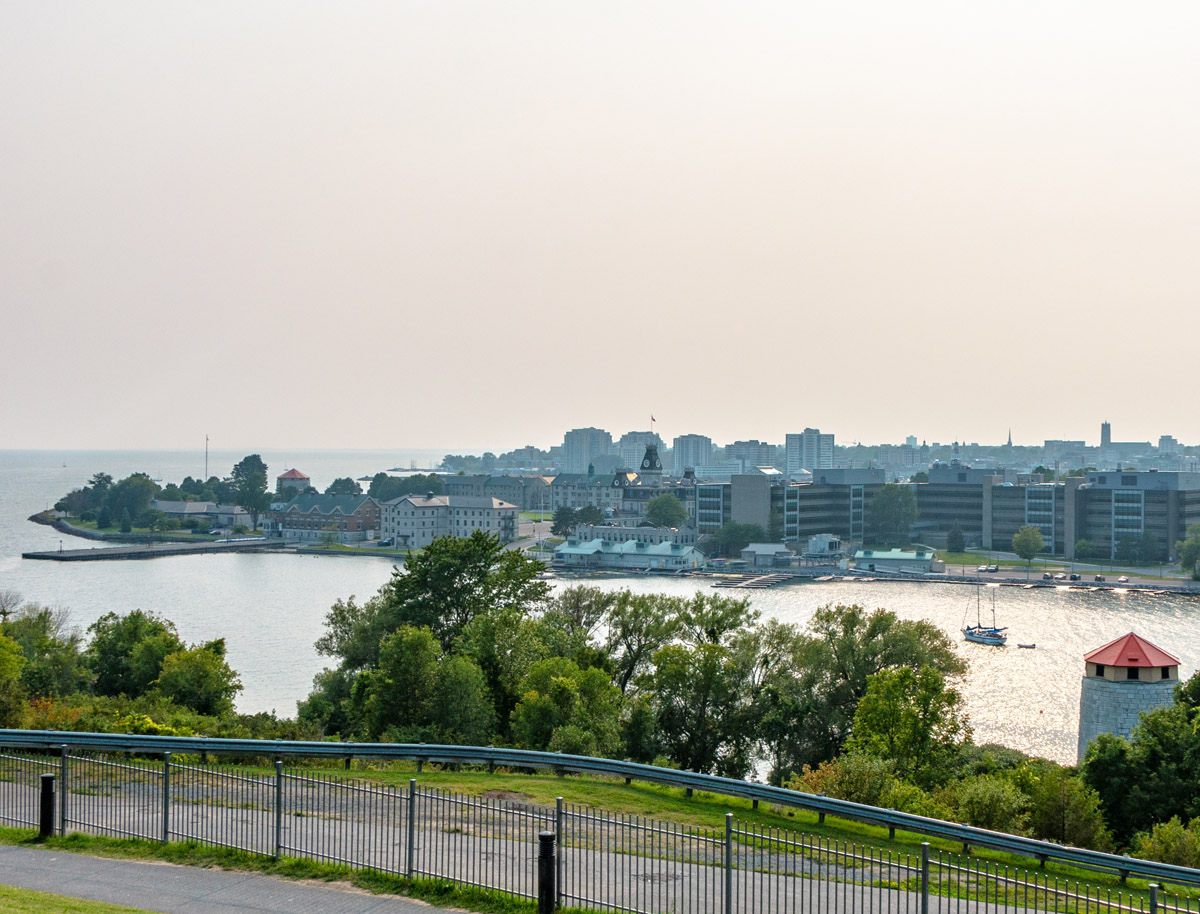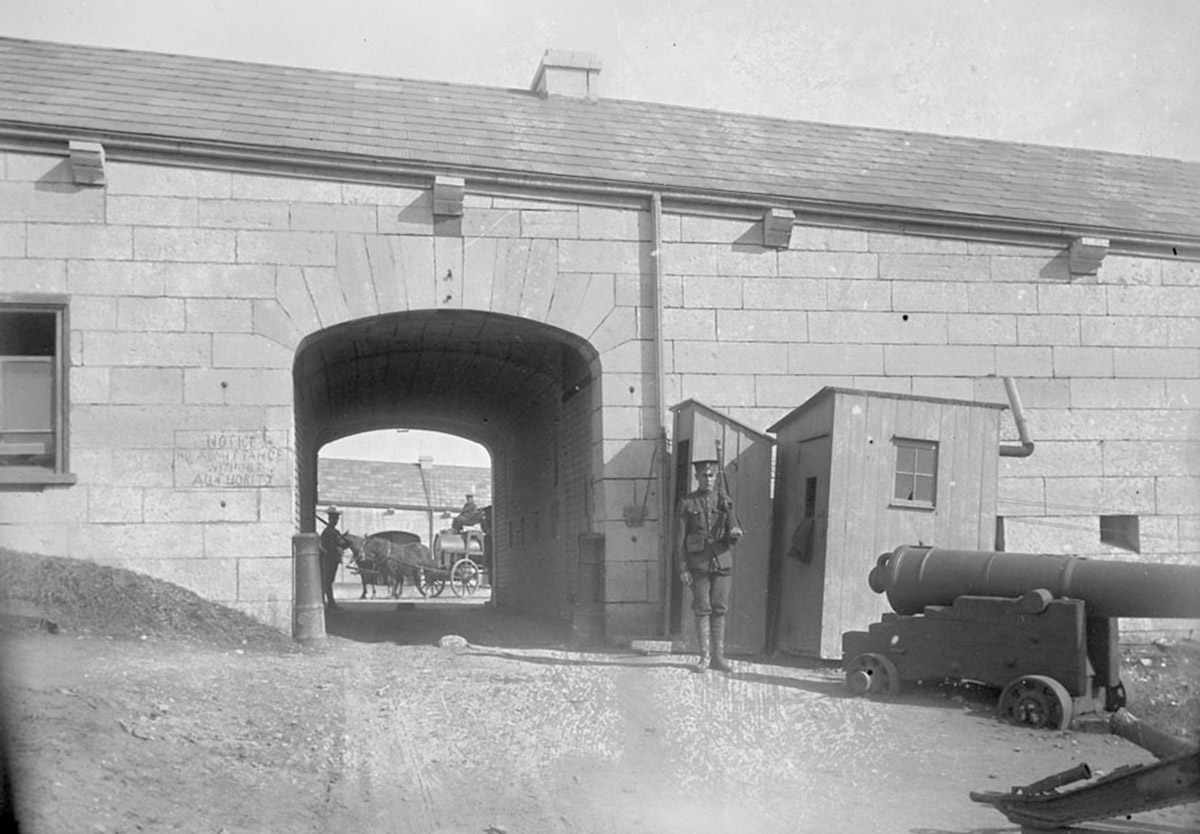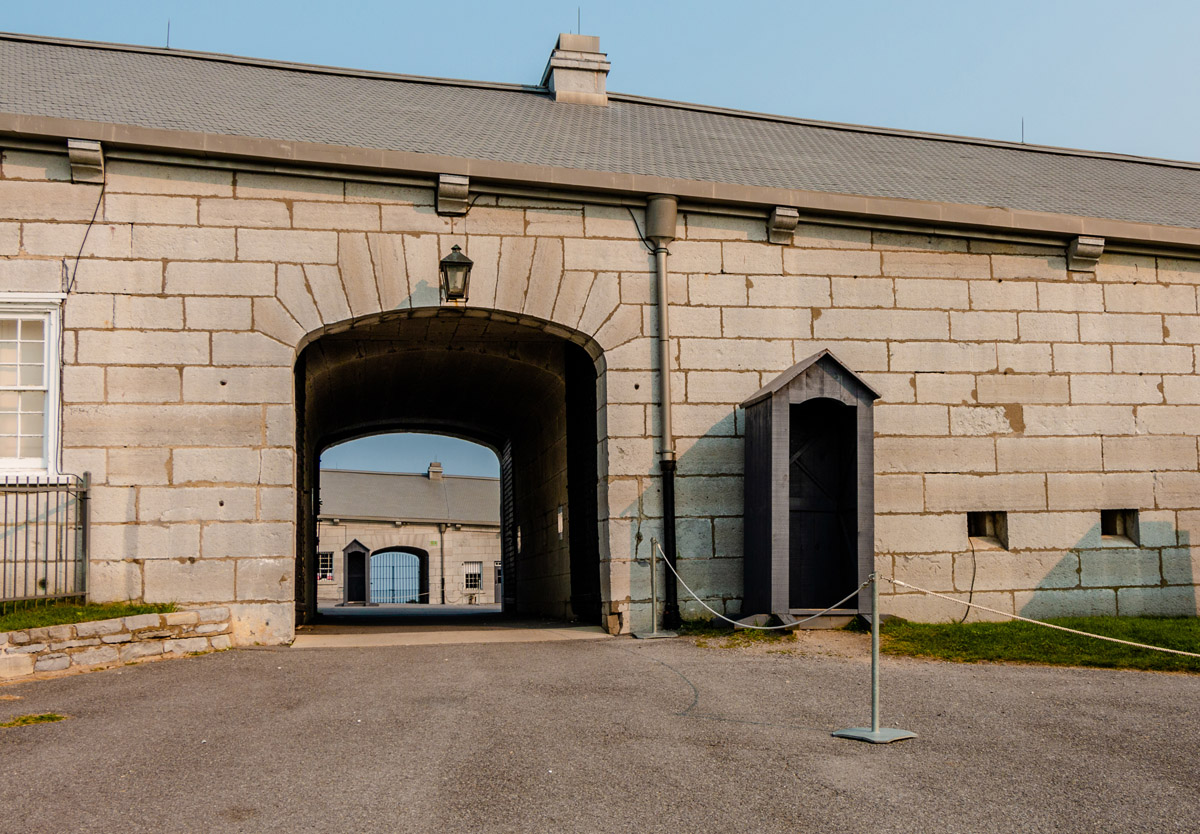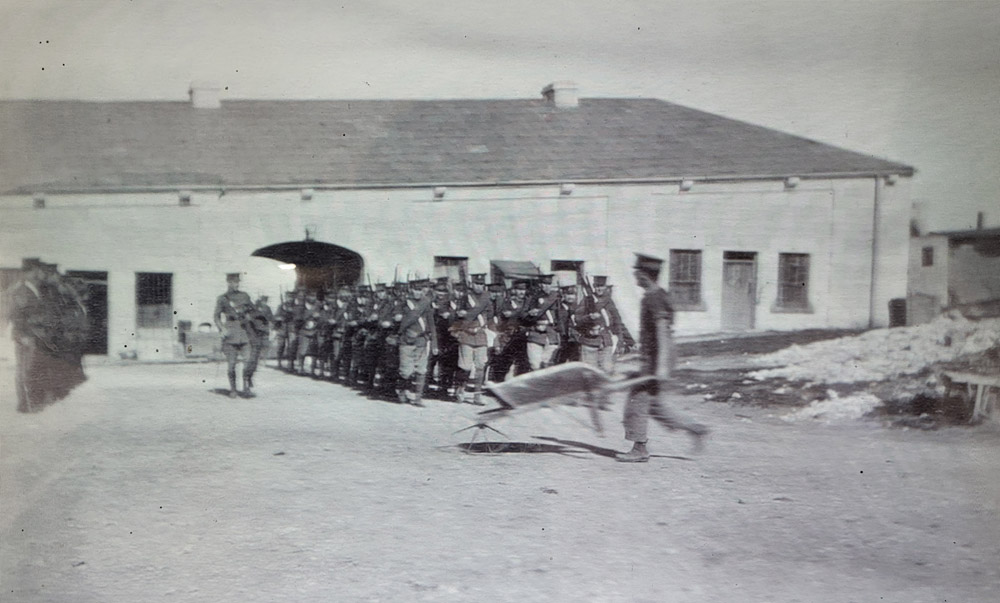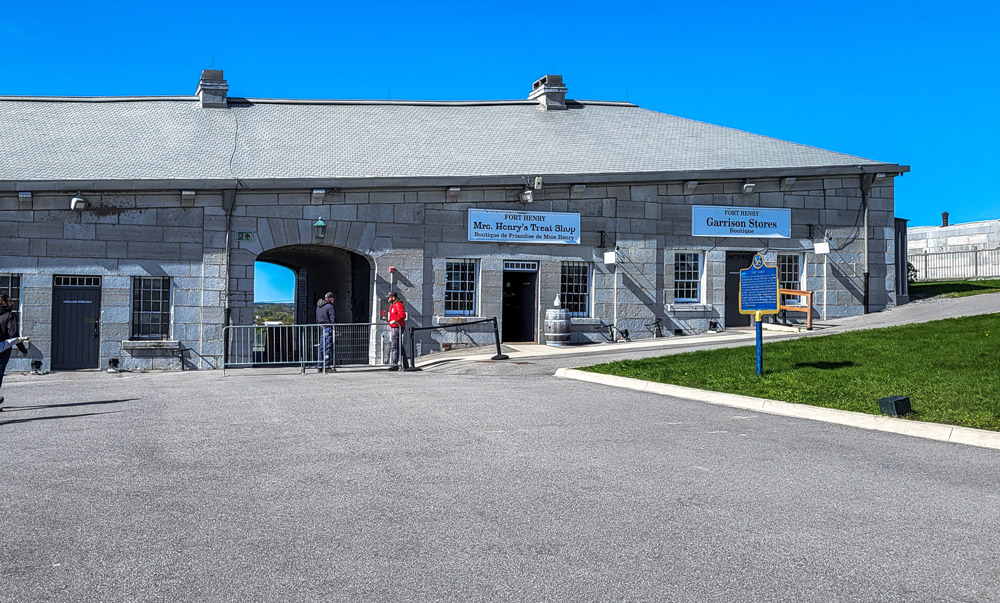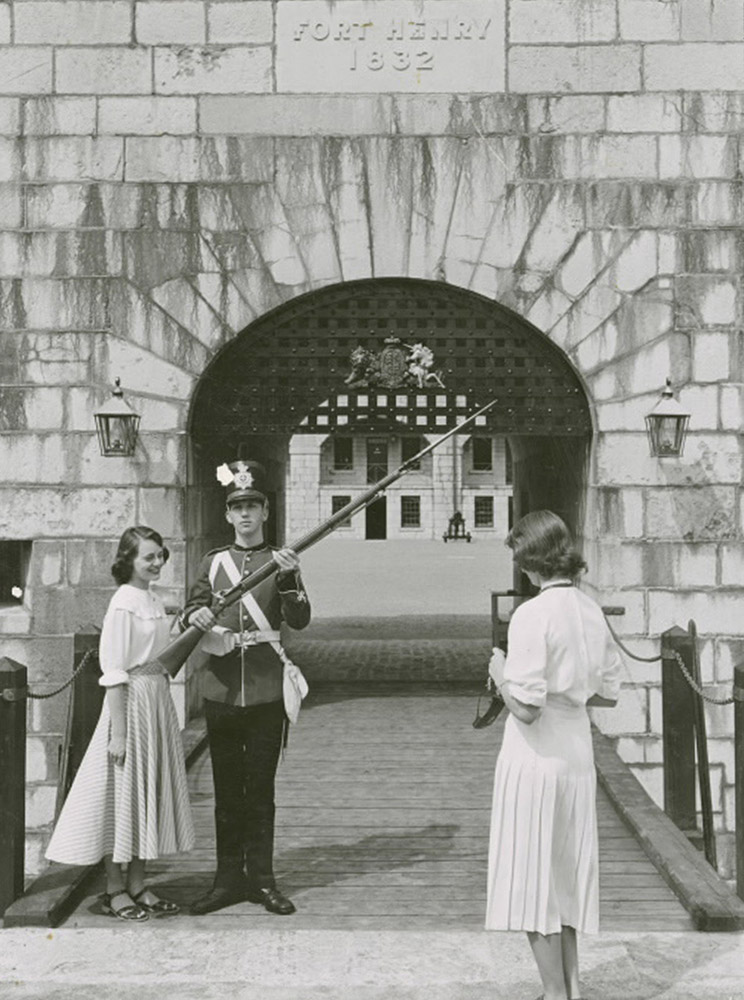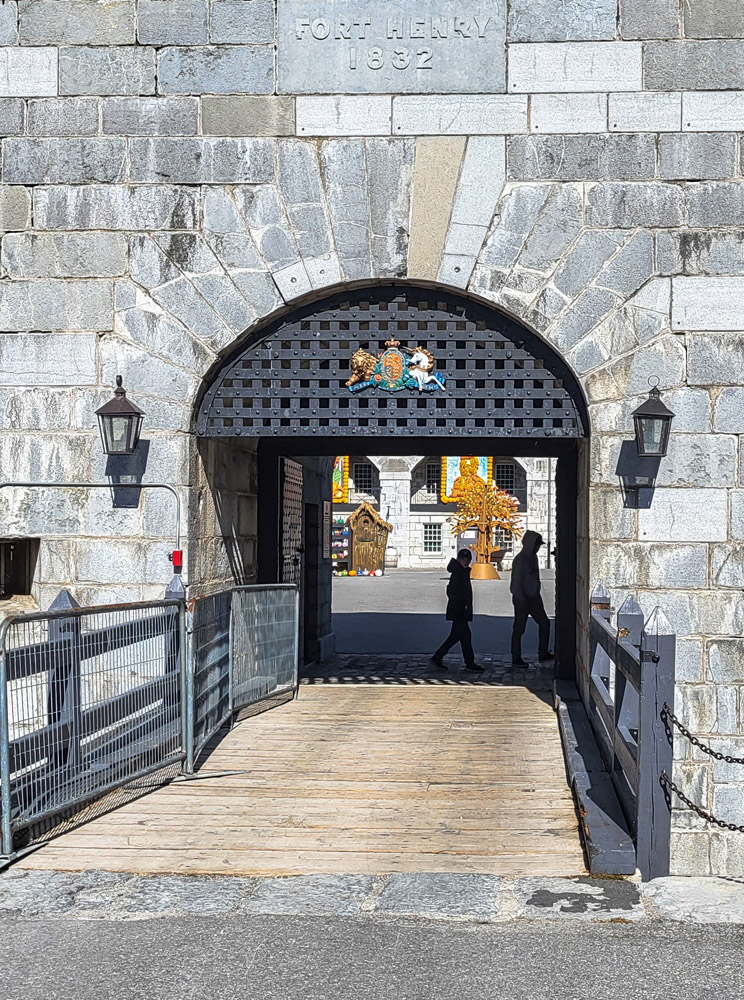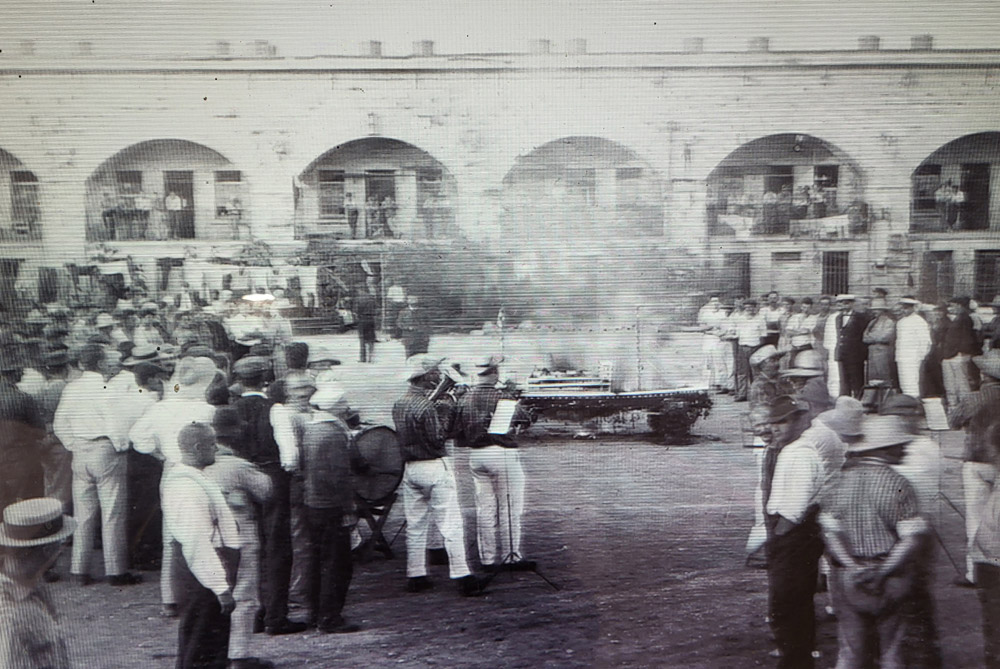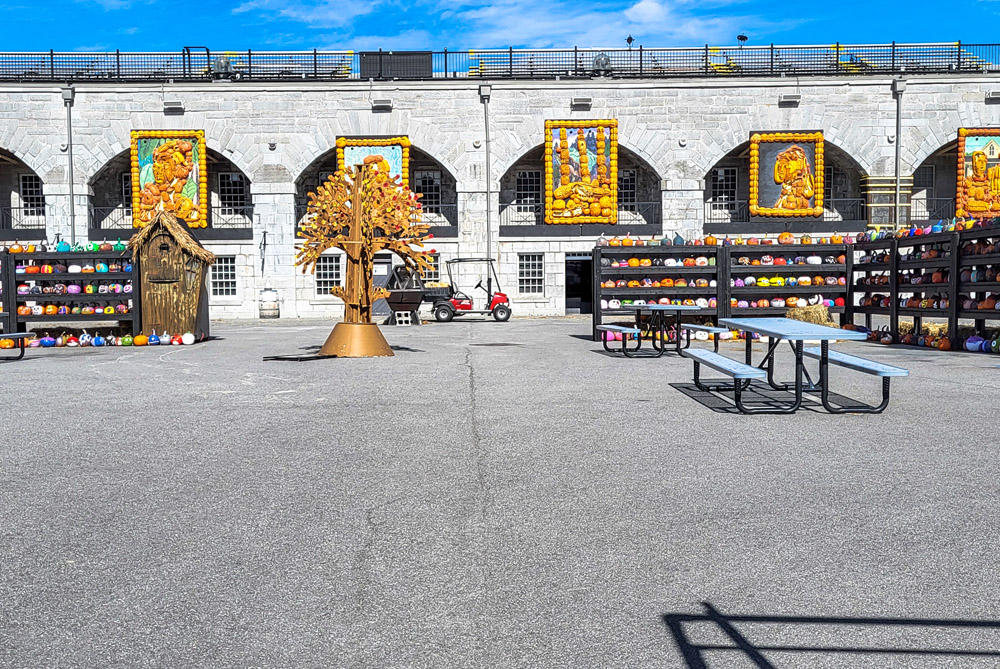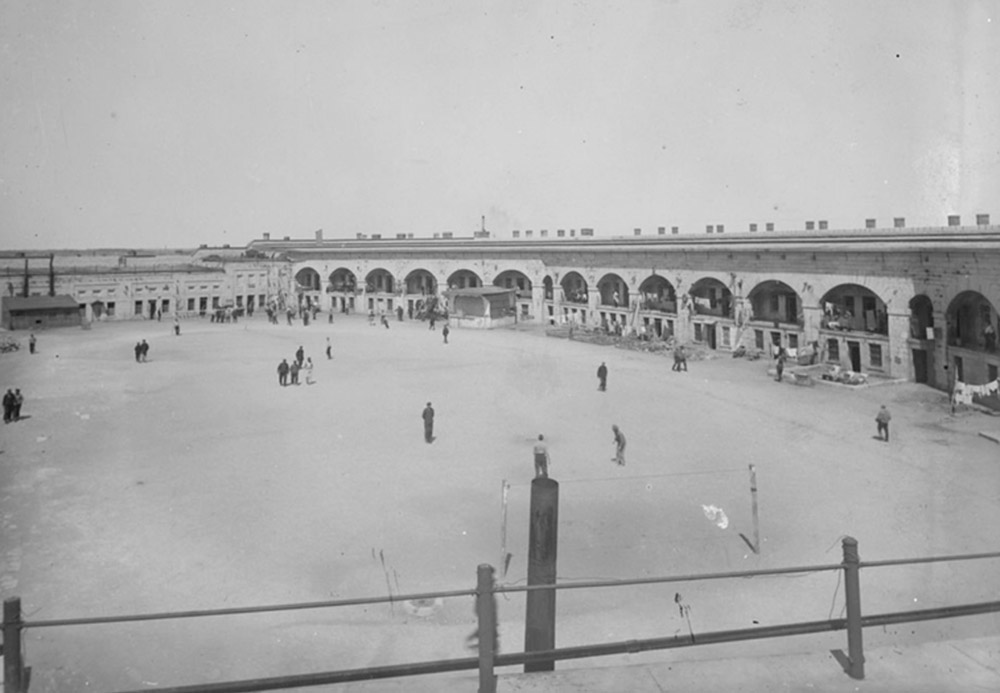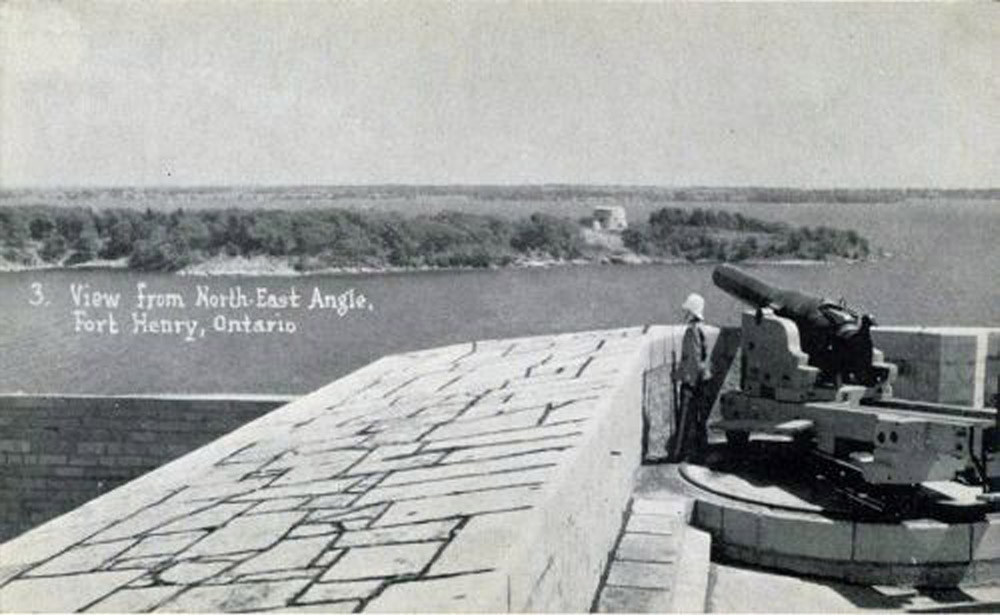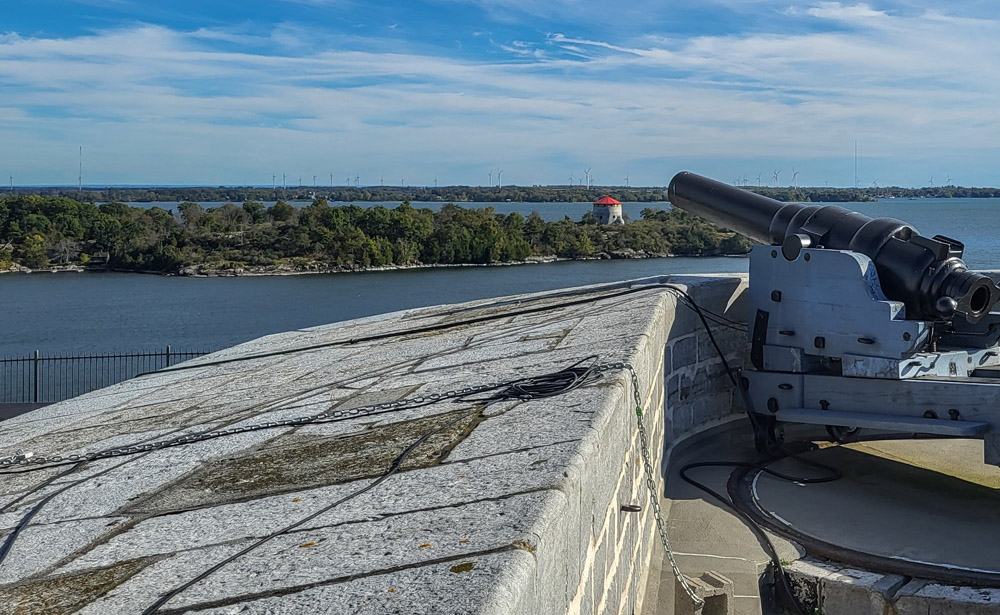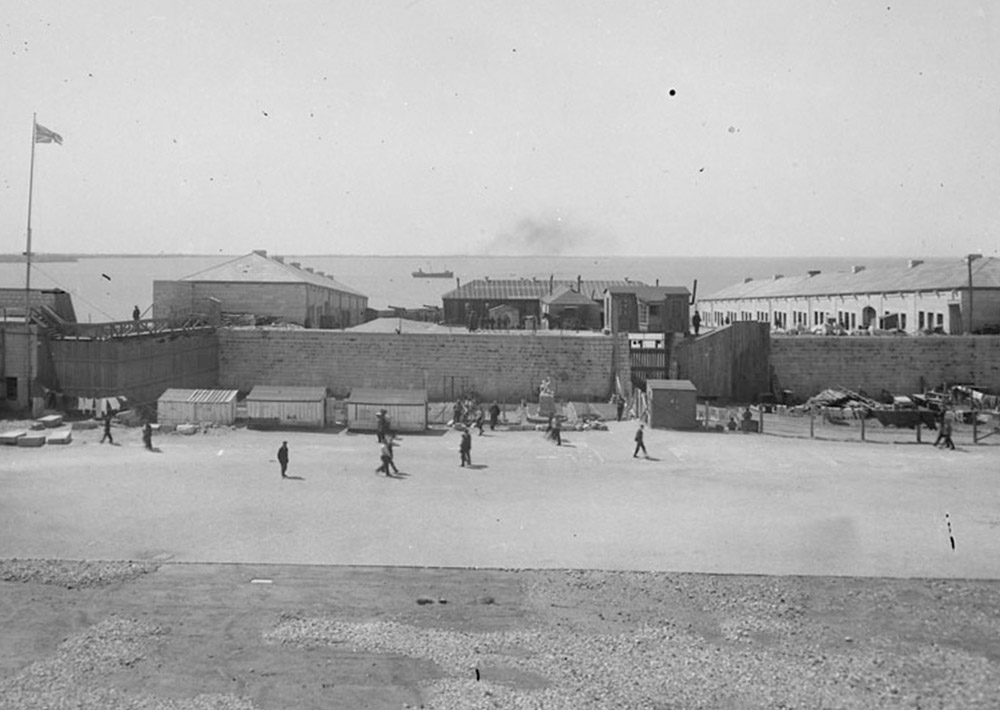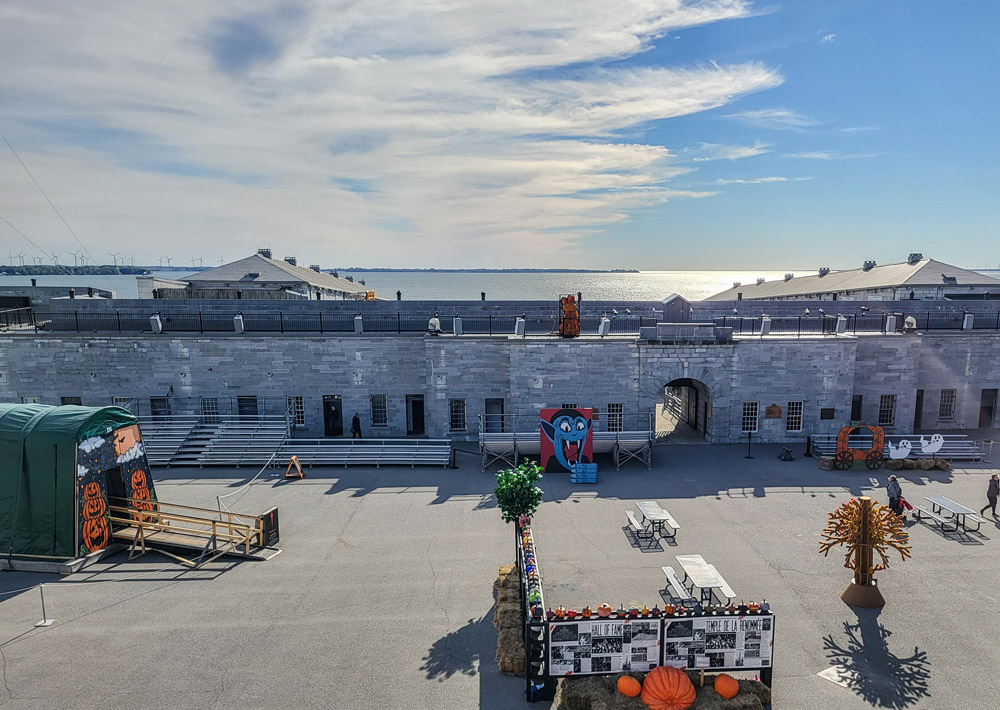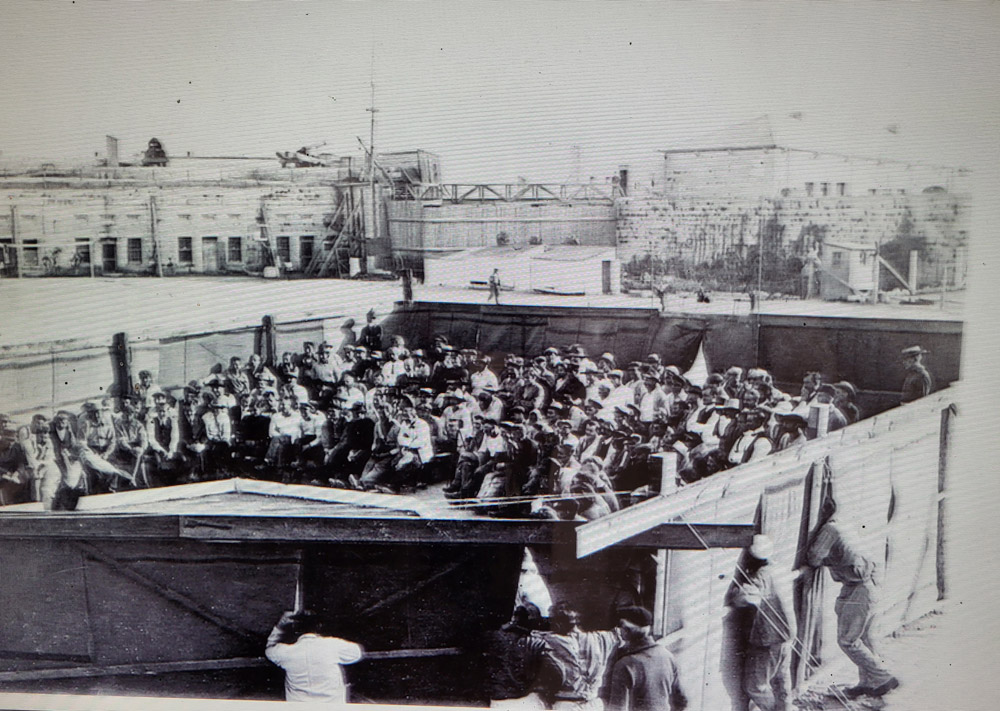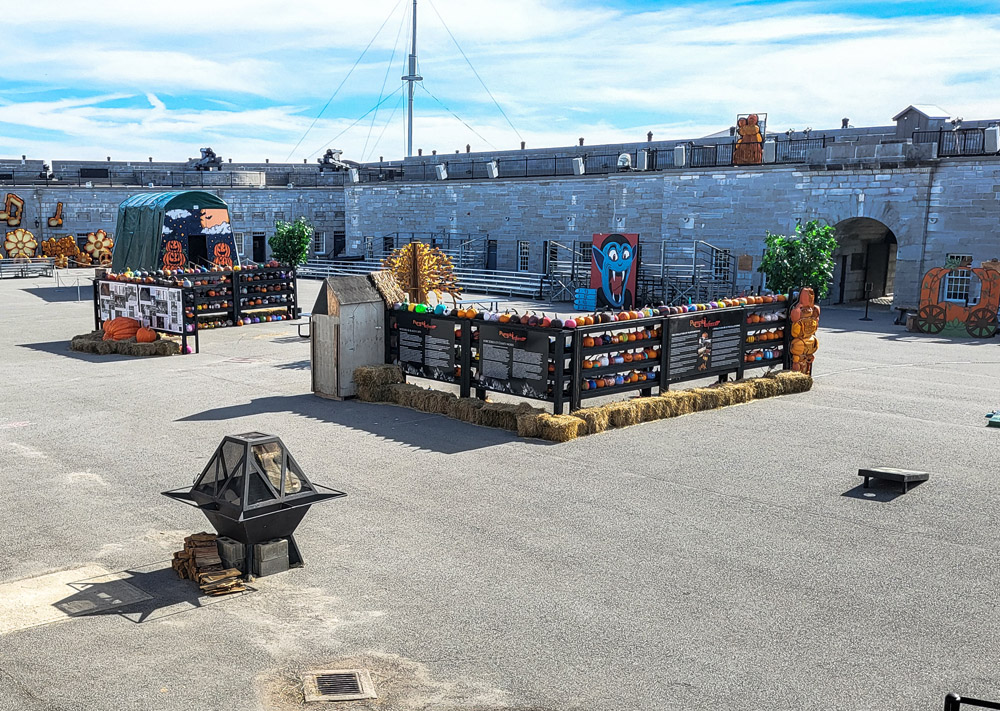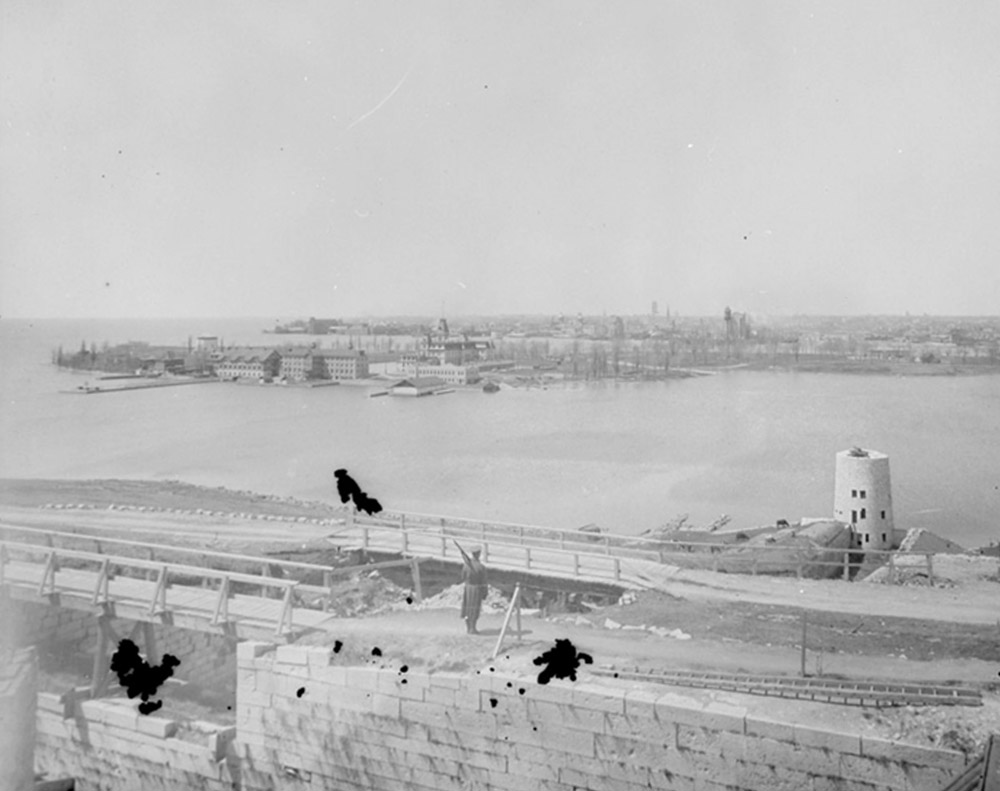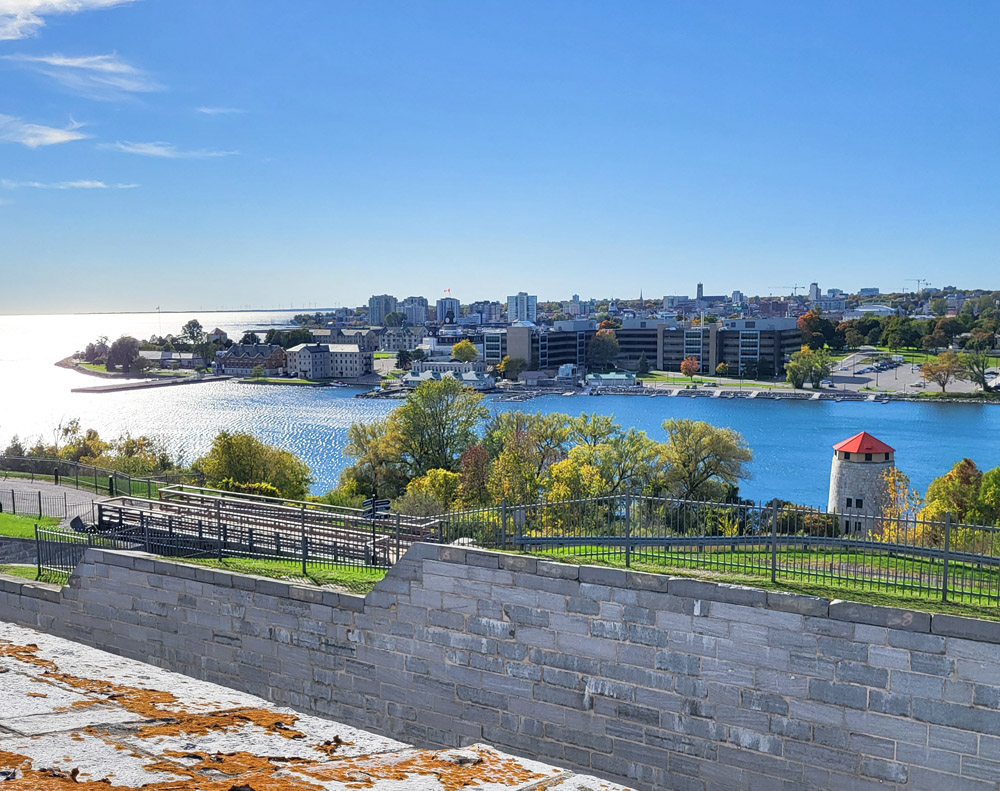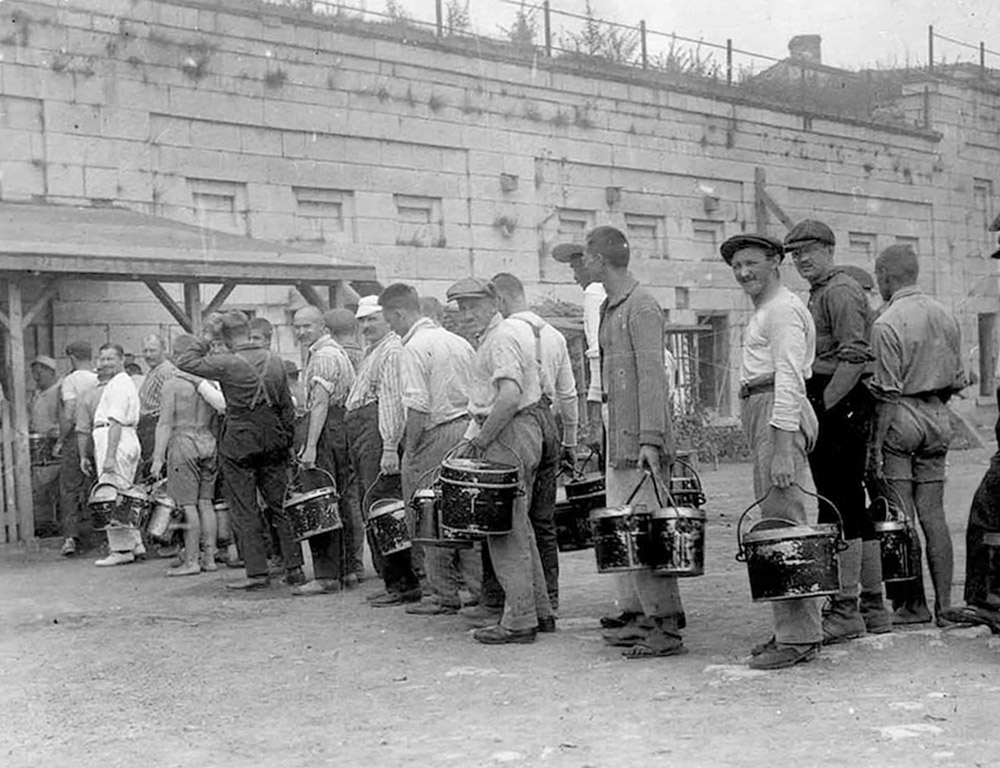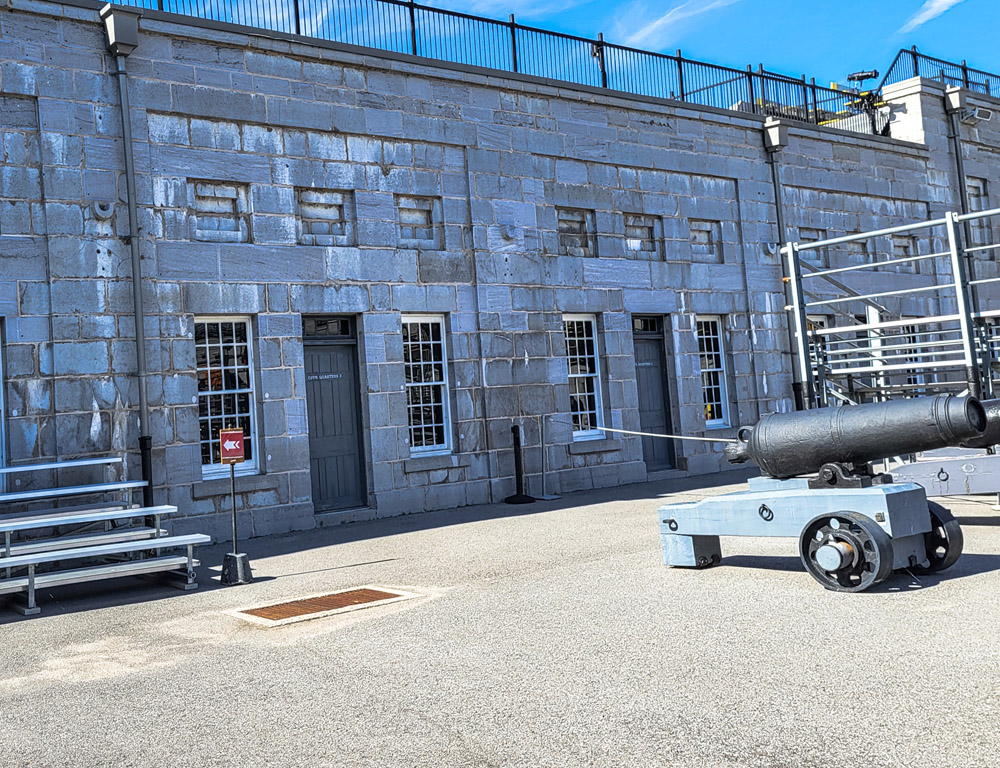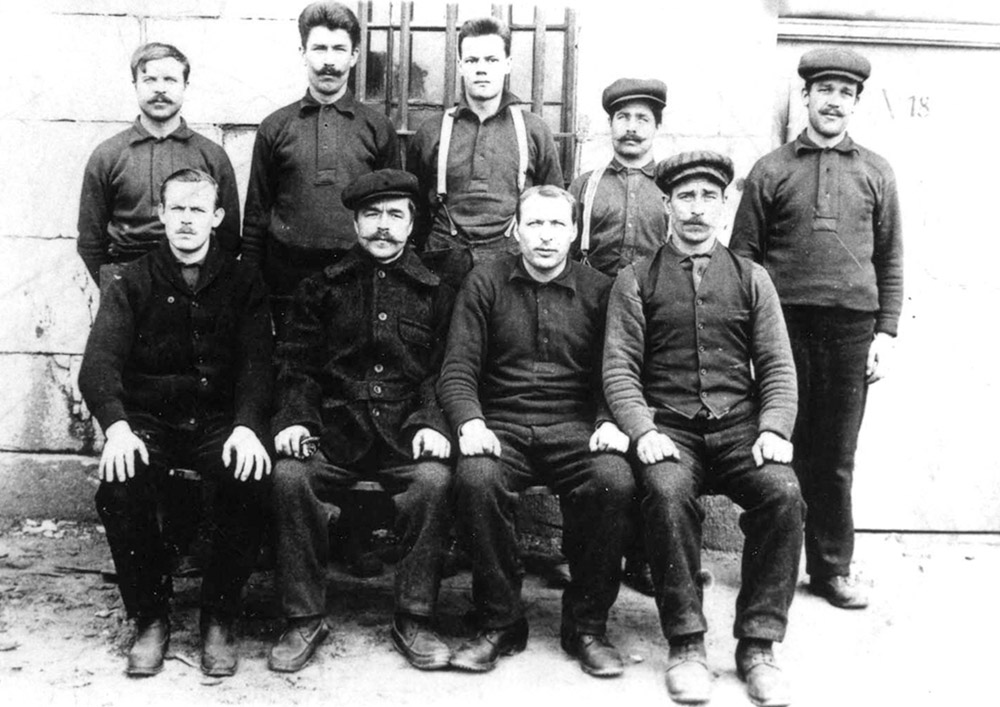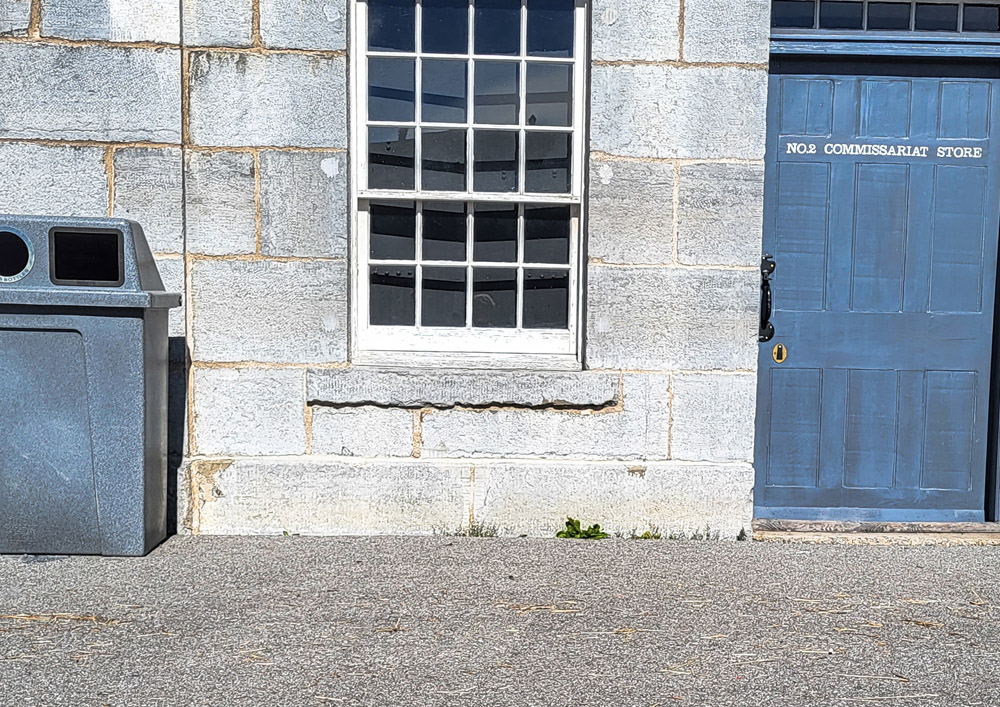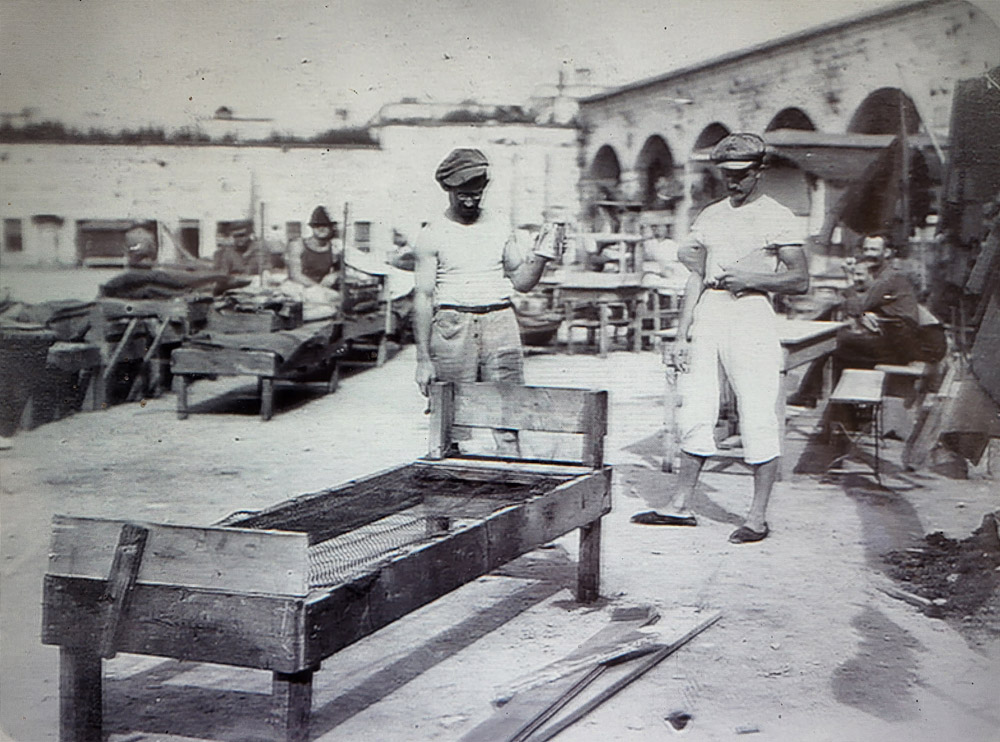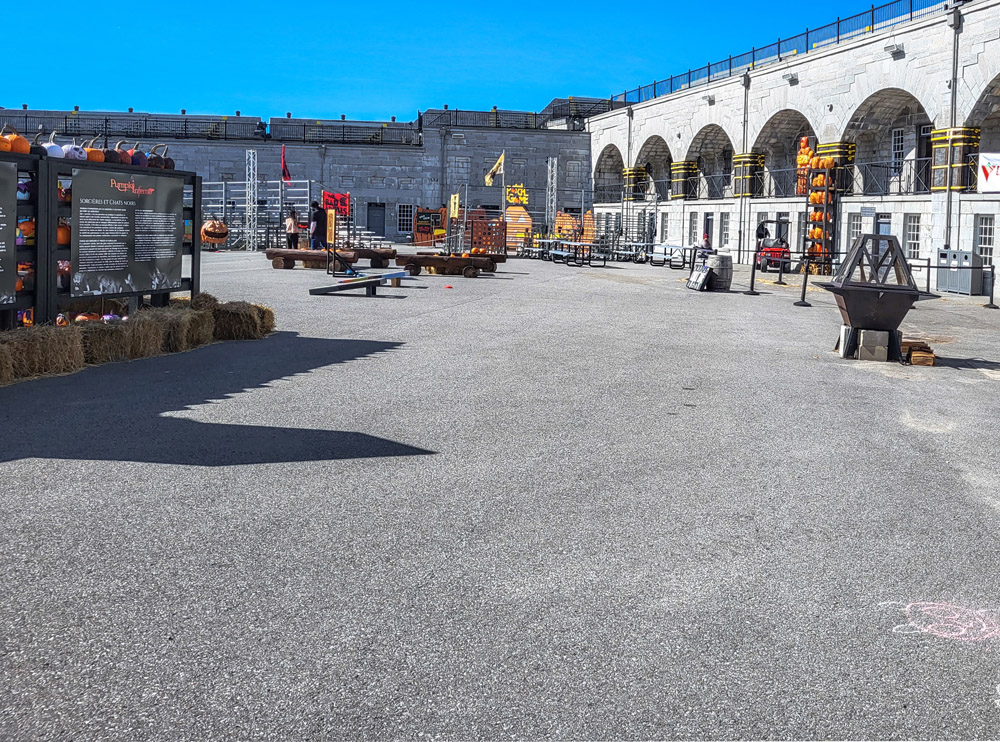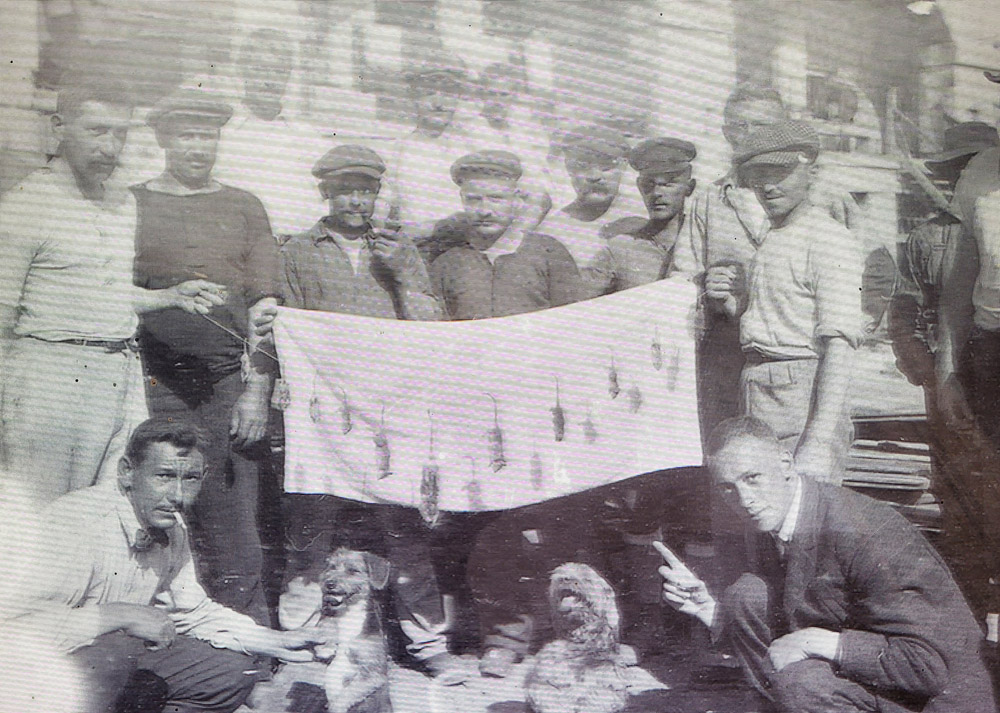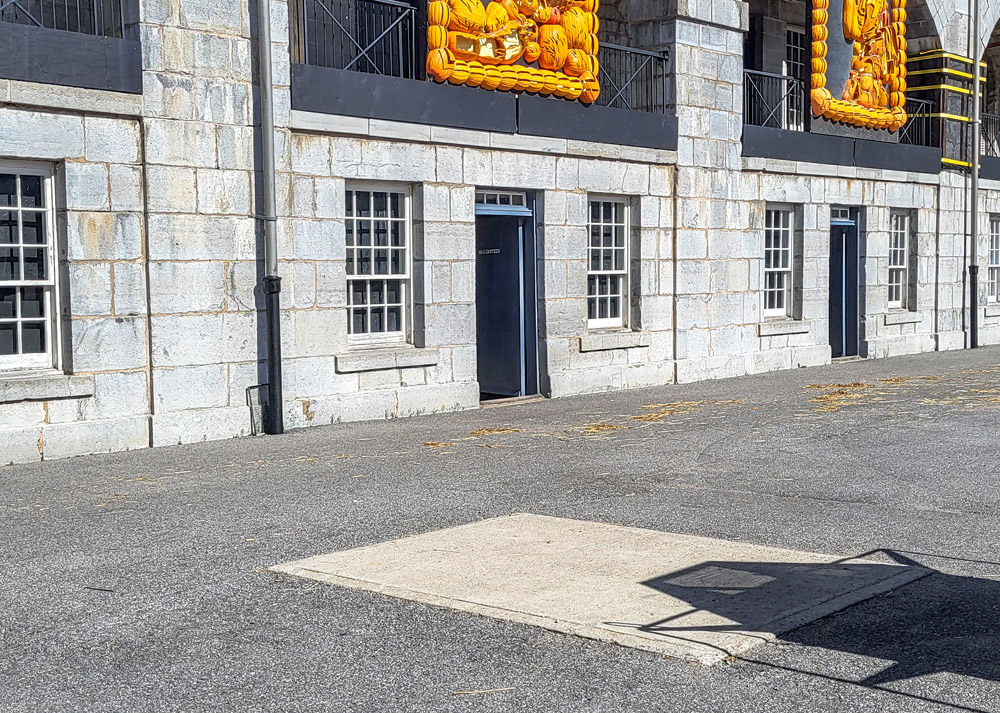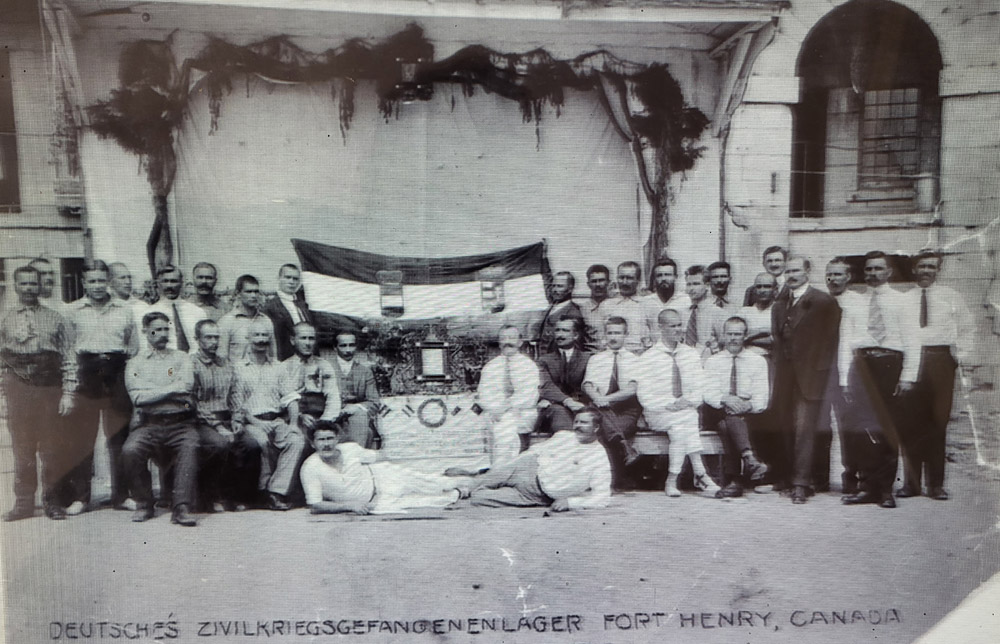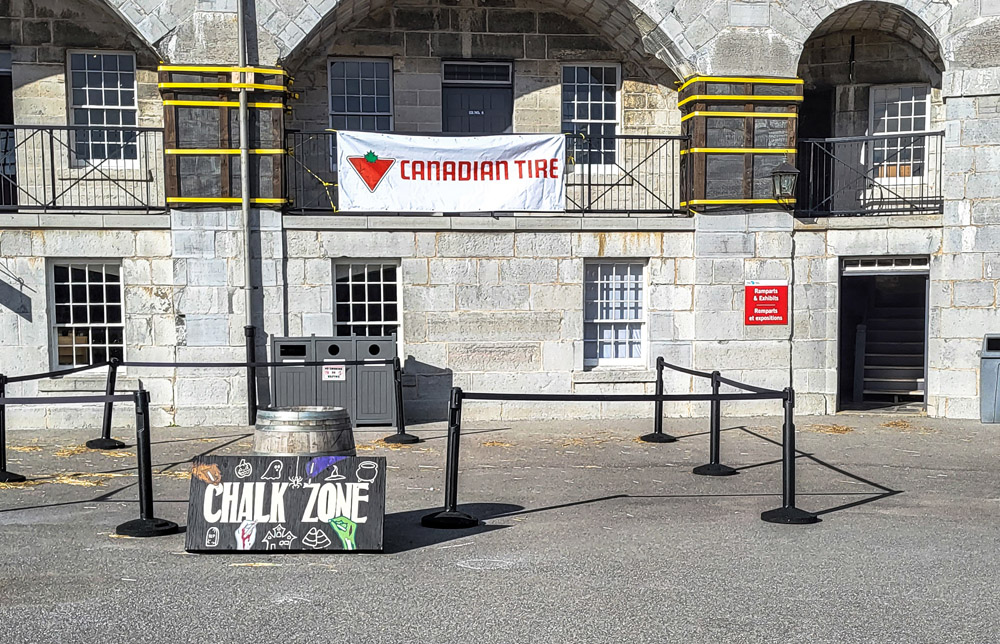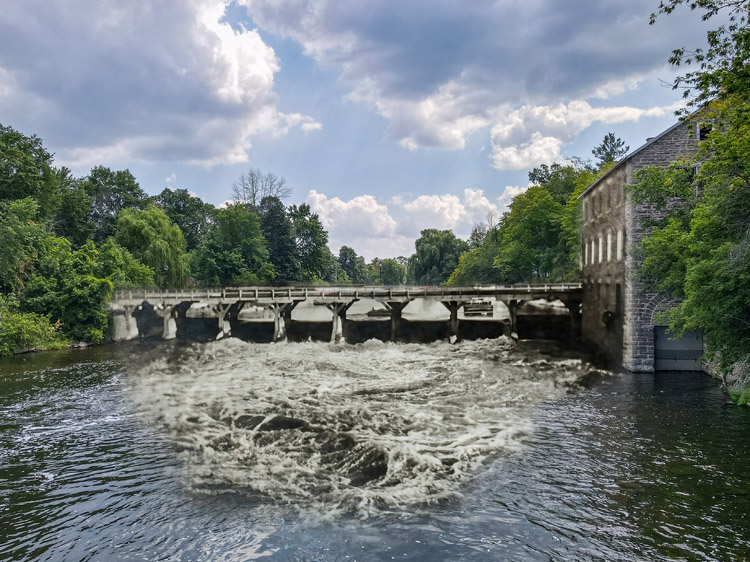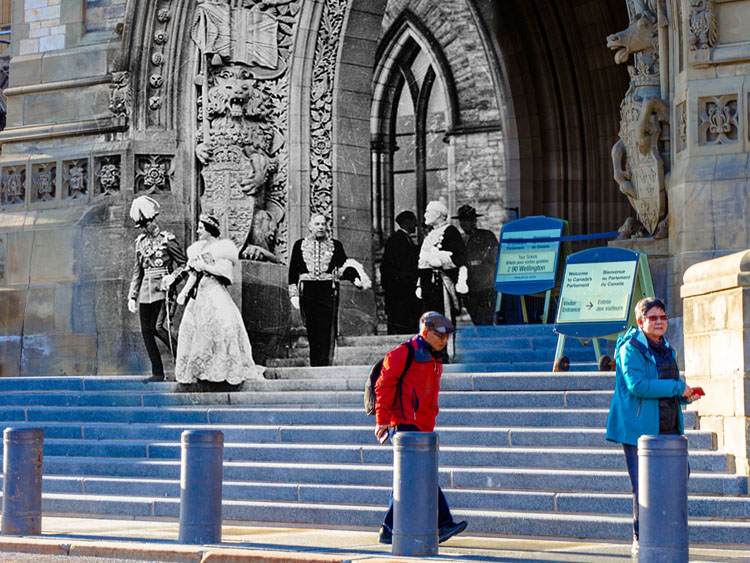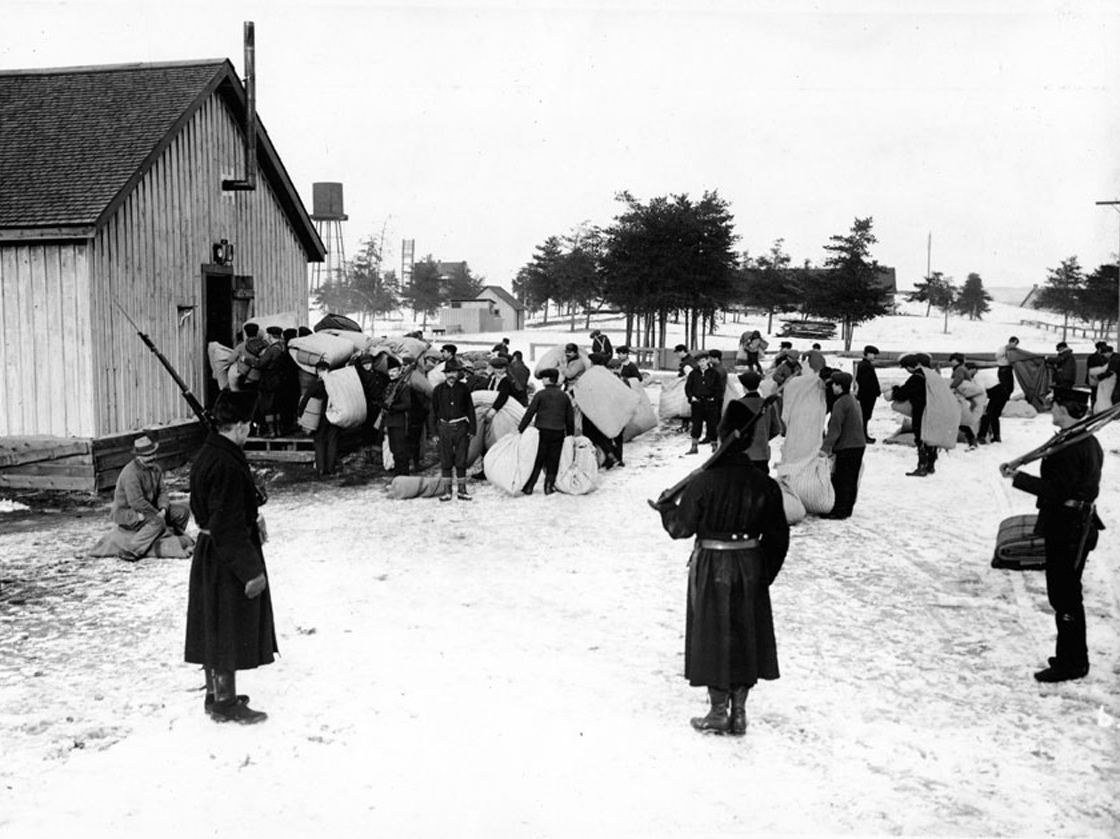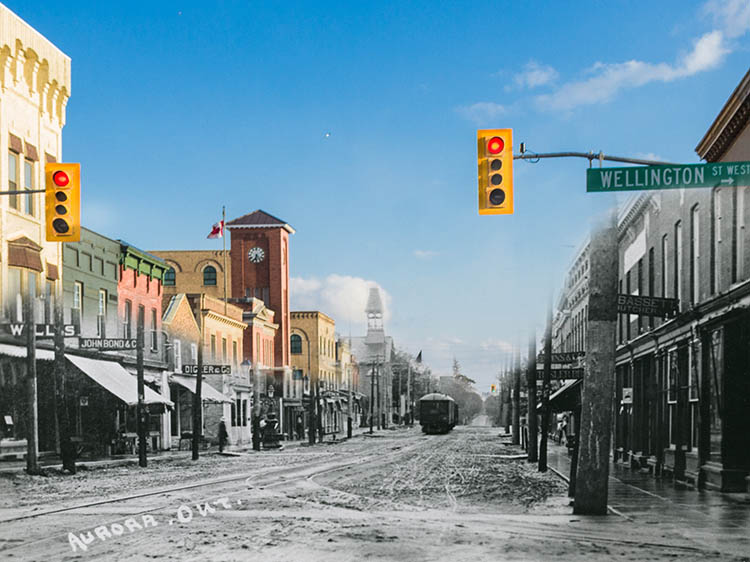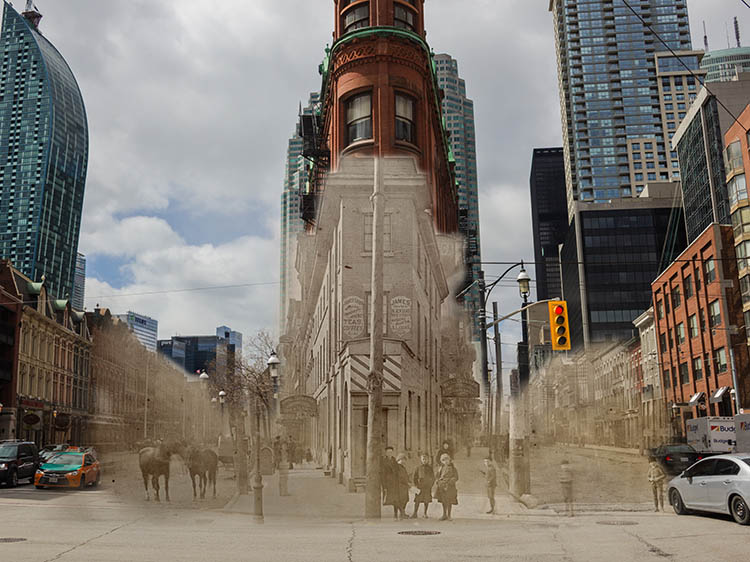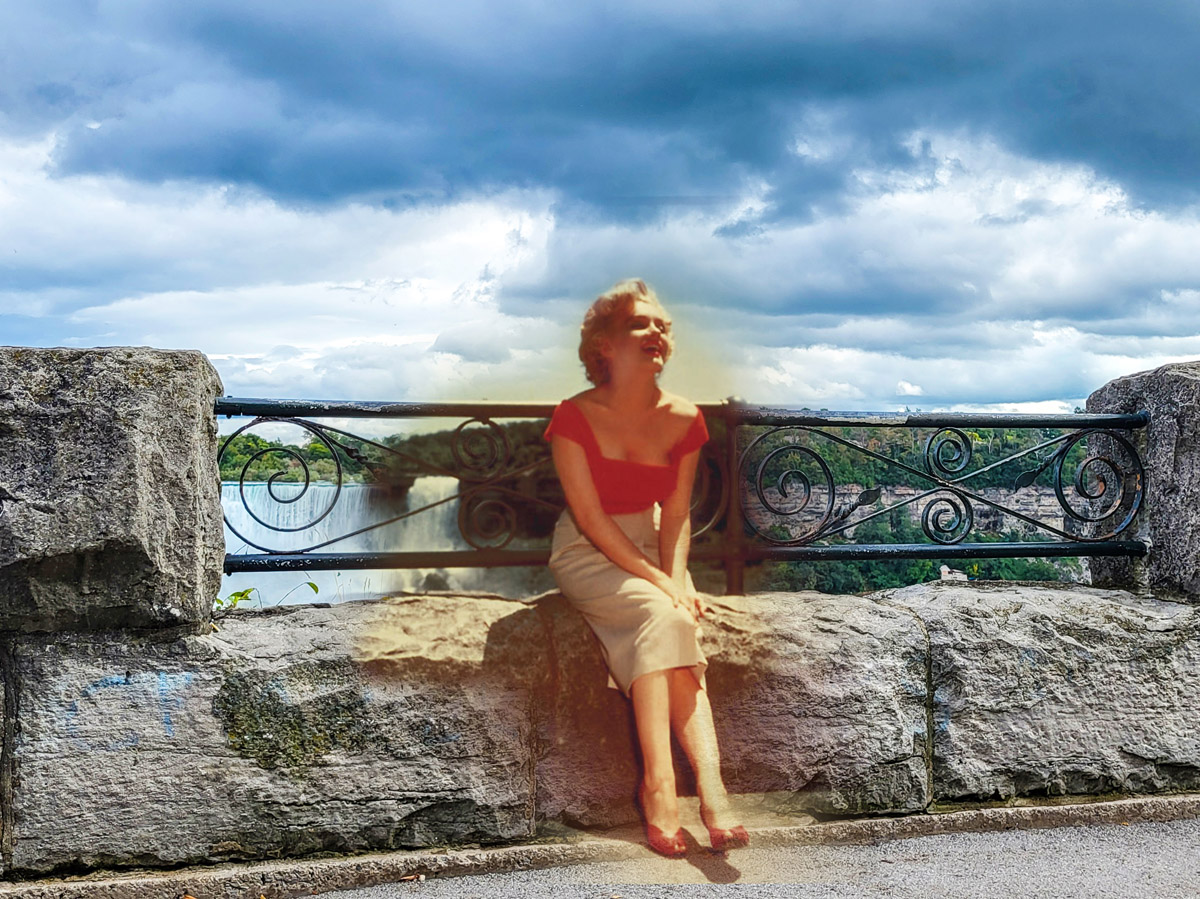Walking Tour
Imprisoned at Fort Henry
Kingston's Internment Camp
Alexa Dagan
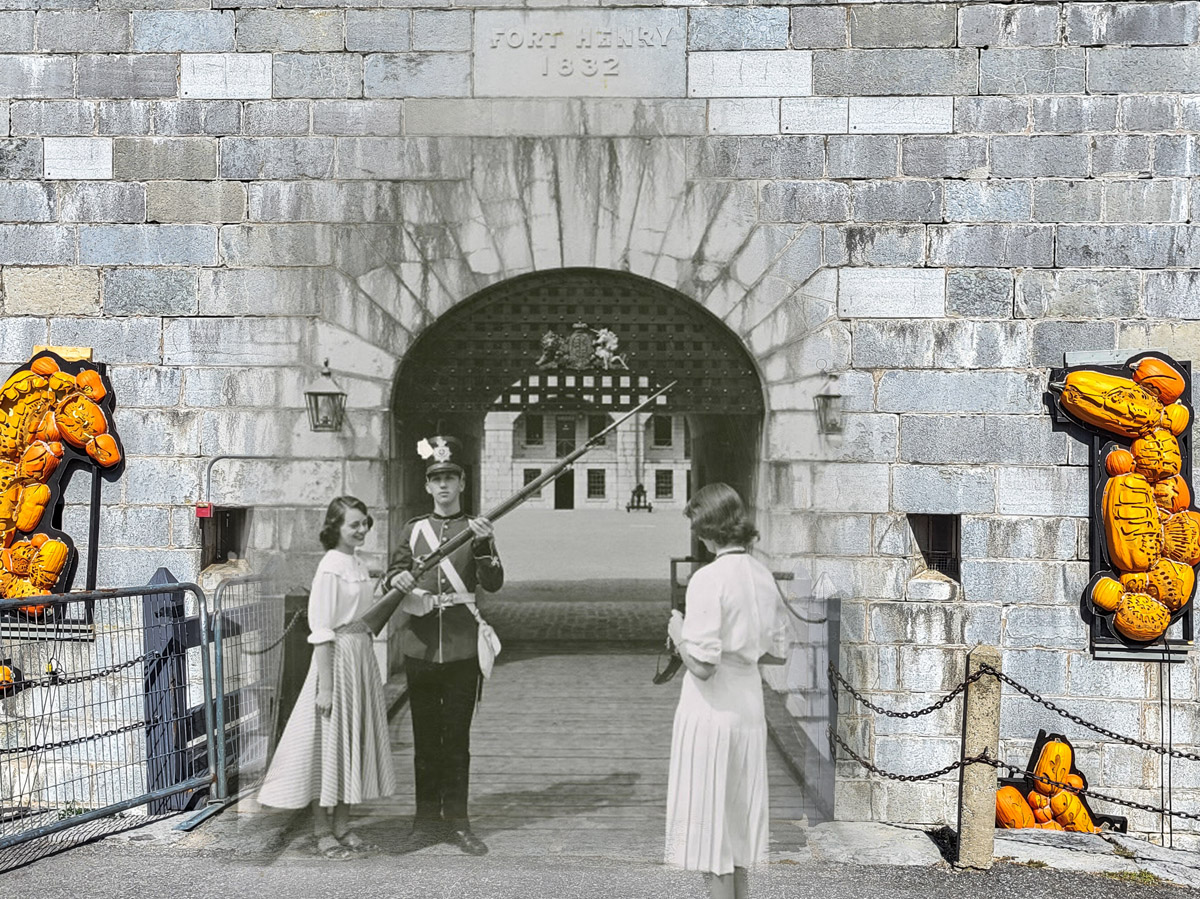
This imposing fort on the shores of Point Henry was first envisioned as the primary line of defense against American aggression during the War of 1812. The point is situated at the mouth of the St. Lawrence River, a vital trade route, making it a site of great strategic importance. The original fort was replaced in the 1830s, after the completion of the nearby Rideau Canal, making Point Henry the centerpiece of a trade route connecting the St. Lawrence, Rideau Canal, and Lake Ontario.
While the War of 1812 passed without an American attack on Point Henry, the risk presented by American expansionism was never far from the minds of the British, and later, Canadian governments. The fort was garrisoned by troops of each nation respectively, until 1891, when it was effectively abandoned and fell into disrepair. When the fort was occupied again years later in 1914, it was not to defend the nation against foreign enemies, but to contain those who were thought to be an internal threat to Canadian security.
When Canada entered the First World War, the Austro-Hungarian Empire became the nation's enemy in a conflict that spanned several years and continents. While the majority of the fighting took place in Europe, many soon became suspicious of the German and Austro-Hungarian immigrants who had made Canada their home. As a result of xenophobia and growing suspicion towards these settlers, the government called for the imprisonment of the so-called "enemy aliens" who had initially been welcomed to Canada as new settlers. Over the course of the war, over 8,500 men, with some women and children, were interned in 24 camps and receiving stations across Canada. Fort Henry, an empty and dilapidated fortress, became the first permanent First World War internment camp in Canada.
This project has been made possible by a grant from the Endowment Council of the Canadian First World War Internment Recognition Fund.
1. Mackenzie Building and Fort Henry
Library and Archives Canada 3317310
ca. 1900s
This view looks across Navy Bay towards the Royal Military College. Today, and in the late 19th century when this photo was taken, the three towers of the Mackenzie Building make it an easily recognizable landmark. This notable structure was built in 1876-1878 and was originally used to train military and civil engineers. The Mackenzie Building and Fort Henry where we currently stand are both designated as National Historic sites.
2. At the Gate
Library and Archives Canada 3550131
ca. 1915-1918
A soldier stands guard at the outer gate of Fort Henry during the First World War. The fort had previously been used as a garrison for British and Canadian soldiers, but during the FIrst World War it was repurposed into an internment camp for so-called 'enemy aliens.' The first internment facility to be established was a receiving station in Montreal, but Kingston followed only days later as the nation's first permanent internment camp on August 18, 1914. It remained in use for most of the war, finally ending internment operations on May 3, 1917. While World War I ended in 1918, some internment camps remained in operation until 1920.
3. The Internees
The local Kingston Regiment, the Princess of Wales' Own, march into Fort Henry for garrison duty. Less than a month after opening as an internment camp, Fort Henry held as many as 200 internees. While some of the internees were German and Austrian Prisoners of War, the majority were Austro-Hungarian enemy aliens from Ukraine, Poland, and other constituent nationalities of the Austro-Hungarian Empire. One man, recalling his time as an internee, estimated that out of his friends in camp, as many as 80% were Ukrainian.1
4. Visit Fort Henry
Two women and a uniformed guard stand at the gate of Fort Henry. One woman poses close to the guard as the other woman prepares to take their photograph. Between the world wars, the fort opened as a museum and historic site, but the museum was temporarily closed during World War II when it was again used to hold Prisoners of War. This photo was likely captured after 1948, when the museum reopened to the public. Since 1948, Fort Henry has been in continuous operation as a museum and interpretive center.
5. The First Year
On the anniversary of their internment, the enemy merchant seamen perform a ceremony on the Fort's parade ground. An internee band plays instruments while a crowd gathers to watch a symbolic burning.
* * *
"We were well guarded. There was the fort's wall, then a deep ditch. Very deep and wide! Inside the fort there were fully armed soldiers marching around at all times. And they were careful. There were 12 cannons on the walls, on tops of the buildings. I must say that the fort wasn't in good shape. There were holes all over. You could even see through the walls at some points. We had to fix those. There was even a danger of some of the walls collapsing."1
6. Keeping Active
This photo, taken from the fort ramparts offers a view of the grounds. Several internees are milling about, likely playing a game of soccer. A net is visible in the foreground of the photo.
* * *
"In Canada I knew more about conditions in Ukraine than many people over there did. Even when I was in Fort Henry I knew about the rise and fall of the Ukrainian Rada, about the course of the war, everything… We were well informed over here, even in the camps. Regrettably, the West didn't believe in its own press, or in us. They are guilty for this and will yet learn the mistake they made then, and pay for it!"1
7. Towers
This postcard looks northeast from the fort ramparts towards Cedar Island and Cathcart Tower. This two storey Martello tower represents Canadian defensive structures during a period of anxiety over American expansionism. Fort Henry was meant to be the lynchpin of an impregnable line of defense fortifications that would protect three of Upper Canada's most important waterways and transportation routes: the Rideau Canal, St. Lawrence River, and Lake Ontario. However, only Fort Henry and four Martello towers, including Cathcart, were built.
8. From Fort to Prison
This photo was taken from the northern ramparts of the fort and looks south across the parade grounds, with more fort buildings visible behind. Two cannons are visible to the left of the photo, and guards patrol the ramparts above the internees.
Compared to many internment camps across Canada, Fort Henry was one of the few that housed internees in a permanent, pre-existing structure. The majority of internees found themselves in what can be described as remote forced labour camps, where they were forced to build roads, clear land, and do whatever was asked of them at gun and bayonet-point. Such camps were usually built partially by the internees themselves and resemble a compound of several rudimentary buildings surrounded by barbed wire fences.
* * *
9. A Shrewd Performance
A large group of internees crowds inside a makeshift outdoor theatre for a show. The internees made up both the performing troupe and the audience. While the stage is out of view, actors in the foreground peek through the ramshackle theatre walls at the audience. Theatre was one activity that helped pass the time, and helped keep up camp morale. The authorities encouraged this as low prisoner morale would often lead to increased acts of resistance and more trouble for the guards.
* * *
The three prisoners and the one guard were some ways from shore when the guard became suspicious and insisted they turn back. The men responded by overpowering the lone guard, tying him up and storing him in the rear of the boat. They used the extra gasoline to flee across to the American side of the river. People on that side of the river later discovered the incapacitated, but uninjured guard where the prisoners had left him in the boat. The three escapees were never recaptured.1
10. Repair
This view looks southeast from the fort ramparts towards the Royal Military College and beyond, capturing some of the Kingston skyline. The date of this photo is unknown, but the fort appears to be in a state of disrepair or possibly under construction. Internees at Kingston were put to work repairing the fort for 25 cents a day, then were eventually sent to other sites across Canada, where they were paroled to work in the mines, railroads, and lumber camps.1
11. Bread Riot
This photo captures a long line of Internees queuing up for a meal. The bucket every man holds likely held his meals for the day. In order to align with international standards for treatment of POWs, internees were fed meals of the same quality and quantity as those given to Canadian troops. However, shortly after Fort Henry ceased internment operations in May 1917, foot shortages in Canada lead to a tightening of the internees rations. The food restrictions and other mistreatments stirred up anger in some camps, even leading to riots in some cases.
* * *
"At Fort Henry, suspecting that soldiers were pilfering inmate food, the prisoners there engaged in a battle of wills with camp officials over control of the kitchen. The tension soon escalated into an open confrontation, requiring a contingent of guards, using fixed bayonets, to subdue the mob. Two prisoners were injured, with one receiving a wound over the ribs and the other to his chest."1
The press blamed lax discipline for the incident, along with the fact the primarily "first-class" German prisoners at Fort Henry weren't kept busy by work like their less fortunate "second-class" Austro-Hungarian counterparts. In response to the accusations from the press, several prisoners were punished with solitary confinement and a diet of bread and water.2
12. Conditions at Fort Henry
Nine internees pose for a photo inside Fort Henry. Behind them, bars are visible on the fort windows. Early on in the war, an American consul in Kingston reported on conditions in the camp, finding that their treatment was good overall and that the conditions of the camp were adequate. According to the consul, "In point of daily conduct and disposition, the officers in charge at Fort Henry have no complaint against their wards, who are described as a happy, contented and clean-living lot of men."1
13. Medical Leave
Internee bunks are dragged out into the parade grounds to be disinfected in the open air. With so many internees living in close contact, pests such as bed bugs and lice, as well as diseases, were a constant concern. Keeping their quarters' clean helped to improve the overall health of the camp.
* * *
14. The Canteen
In this photo, a group of internees pose with a trophy: a collection of rats and mice hanging from a line. Internees were allowed to keep pets such as the two terriers pictured here. Such pets were useful for catching vermin, which could spoil food and spread disease. Note the man on the bottom left with a cigarette, and the third man on the left smoking a pipe.
* * *
15. Celebration and Resistance
Internees celebrate the birthday of Emperor Franz Josef of the Austro-Hungarian Empire. While these celebrations were allowed by the camp guards, celebrating the leader of an enemy nation likely also offered internees an opportunity to express their resistance against their circumstances and gain agency in the restrictive environment of the camps.
Donate Now
If you enjoyed this free content, we ask you to consider making a donation to the Canada-Ukraine Foundation, which is providing urgently needed humanitarian aid to Ukraine.
The Ukrainian people are heroically defending their homeland against a genocidal war of Russian aggression. The humanitarian situation is critical and the needs immense. 100% of all donations made through this link go directly to supporting the people of Ukraine. Recently funded initiatives by the Canada-Ukraine Foundation include demining and removal of unexploded ordnance, and the evacuation of thousands of deaf people from the warzone.
Endnotes
3. The Internees
1. Lubomyr Y. Luciuk, *Internment Operations - The role of Old Fort Henry in WWI,* (Delta Educational Consultants: Kingston Ontario, 1980), 22.
5. The First Year
1. Luciuk, *Internment Operations - The role of Old Fort Henry in WWI,* 31.
6. Keeping Active
1. Luciuk,*Internment Operations - The Role of Old Fort Henry in WWI*, 11.
8. From Fort to Prison
1. Bohdan Kordan, *No Free Man: Canada, The Great War, and the Enemy Alien Experience.* (Montreal, QC: McGill-Queen's University Press, 2016), 51.
9. A Shrewd Performance
1. *The Daily British Whig*, "Kingston," July 4, 1916. https://vitacollections.ca/digital-kingston/3677752/page/6?n=
10. Repair
1. Luciuk,*Internment Operations - The Role of Old Fort Henry in WWI*, 31.
11. Bread Riot
1. Kordan, *No Free Man*, 159.
2. Kordan, *No Free Man*, 159.
12. Conditions at Fort Henry
1. Kordan, *No Free Man*, 54.
13. Medical Leave
1. Luciuk, *Internment Operations*, 9.
14. The Canteen
1. Luciuk, *Internment Operations*, 14.
Bibliography
Kordan, Bohdan. *No Free Man: Canada, The Great War, and the Enemy Alien Experience.* Montreal: McGill-Queen's University Press, 2016.
Luciuk, Lubomyr Y.*Internment Operations - The Role of Old Fort Henry in WWI*. Delta Educational Consultants: Kingston Ontario, 1980.
The Daily British Whig, *Kingston*, July 4, 1916. https://vitacollections.ca/digital-kingston/3677752/page/6?n



